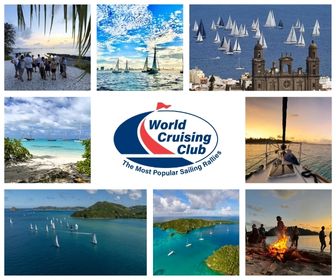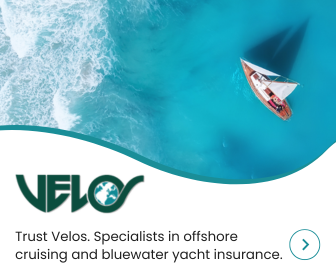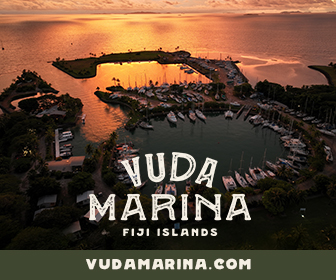Environment: How to Take C.A.R.E. When Anchoring in Coral Reefs
It’s a beautiful tropical bay, palm trees line a perfect white beach and crystal clear waters show an underwater garden of living coral beneath your hull. But where will your anchor land? Richard Chesher, author of Rocket Guides for New Caledonia and Vanuatu poses the question and provides some helpful advice and guidance in this report.
Published 6 months ago
Where will your Anchor Land?
Picture this: You’re gliding into a tropical bay, palm trees lining a perfect white beach, and beneath your hull—an underwater garden of living coral, home to a stunning diversity of marine life. But now ask yourself: where will your anchor land?
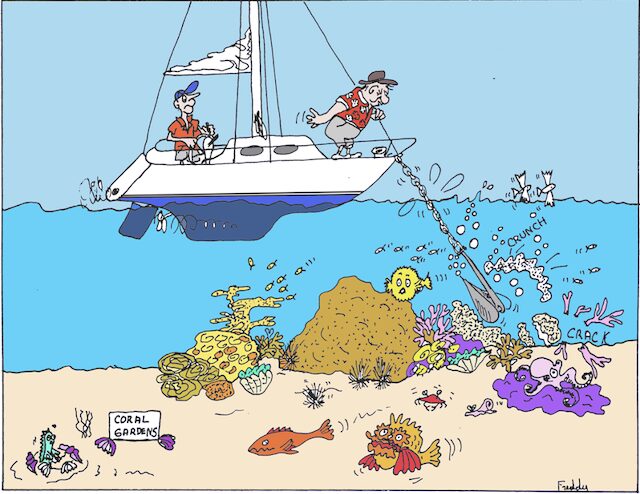

Coral Reefs Are Living Beings—Not Parking Lots
You wouldn’t park your car in a flower bed. So why drop your anchor on a living coral reef? Corals are not just decoration—they’re living animals that build entire ecosystems supporting thousands of species. They’re fragile, slow-growing, and increasingly under siege from human activity.
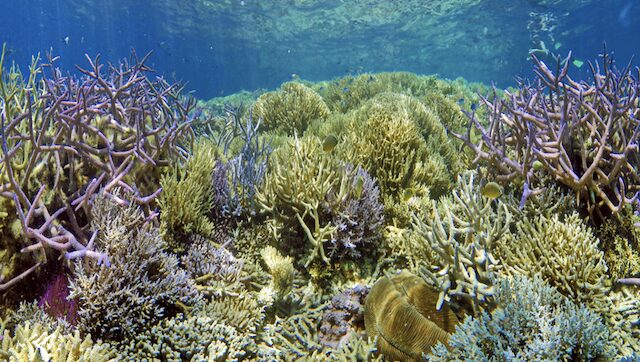

Yacht Anchors: A Hidden Threat to Coral—and to Your Vessel
Anchoring in coral isn’t just an environmental tragedy—it’s also a hazard to your yacht:
- Anchor fouling: Coral is brittle in sheltered areas and can foul your anchor or trap your chain.
- Unreliable holding: Coral heads don’t provide secure holding. Your vessel may drag in a blow and end up ashore.
- Retrieval nightmares: An anchor wedged in a coral crevice may require diving to retrieve—dangerous or impossible in rough weather.
- Costly corrosion: Coral’s abrasive surface rapidly strips the galvanizing from your chain. Re-galvanizing? Good luck—most island nations lack the facilities. A few days in coral could shorten your chain’s life by years.
The Scale of the Damage
Each year, thousands of yachts cruise reef environments in the Pacific. In a single popular anchorage during high season, hundreds of boats may drop anchor. The cumulative destruction is staggering. As a marine ecologist, I’ve surveyed anchor damage across New Caledonia, Vanuatu, Fiji, and Tonga—coral gardens reduced to rubble by well-meaning, but unaware, sailors.


The irony is heartbreaking: many sailors come to these islands to see the coral, yet unknowingly contribute to its demise.
Coral Reefs Are Already Under Siege
Corals face enough threats: overfishing, pollution, warming oceans, destructive storms, disease outbreaks, and population explosions of predators like Crown of Thorns starfish. Anchoring on reefs adds to this pressure—damage that is 100% preventable.
Coral fragments take years—sometimes decades—to heal, if at all. In busy anchorages, reefs never get a chance to recover.
CARE: The Code of Anchoring in Reef Environments
The C.A.R.E. Code promotes sustainable anchoring. It’s simple: Anchor in sand or mud, not on coral. But this requires preparation, awareness and seamanship. Here’s how:
Smart Anchoring Practices in Coral Environments
1. Equip for Success
- Polaroid sunglasses: Essential for spotting sandy patches through surface glare.
- Arrive early: Anchor before 3 p.m., or even earlier if facing into the afternoon sun.
- Depth sounder with bottom trace: Avoid digital-only models. You want to see the bottom type.
2. Anchor Where It’s Safe—for Both Reef and Boat
- Prefer sand or mud. Even if it’s deeper, it’s better than risking damage.
- Be ready to anchor in 20–30 meters of water. Have enough chain (or chain/rope combo).
- If anchoring in mixed bottom, float your chain using pearl floats (not fenders) to avoid dragging through coral. See this excellent guide by Jacaranda: https://www.jacarandajourney.com/floatingyourchain
3. If you don’t have a recording depth sounder and can’t see the bottom.
- Let your anchor just touch bottom—feel the chain. If it grumbles or drags, it’s coral. Lift and try again.
- If the anchor sets quickly and silently, it’s likely sand or mud.
4. Use a Proper Dinghy
A good dinghy with an outboard allows you to anchor farther out in deeper, safer water and still access the shore and reefs. This opens up more anchoring options and reduces crowding in sensitive areas.
Spread the Word – Be an Anchor Ambassador
Help Others
If you see another boat searching for a spot, point out sandy areas. Offer a friendly “Heads up—that’s live coral over there.”
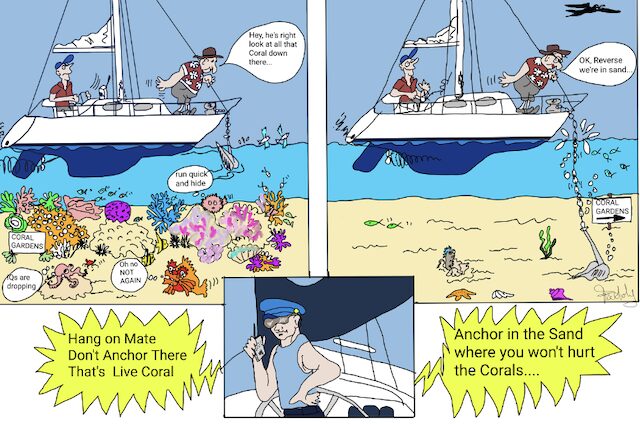

Educate, Don’t Shame
If someone anchored in coral, swim over, say hello, and gently explain why that’s a problem. Most cruisers respond positively—they just didn’t realize the impact.
Use the Radio
During anchoring discussions or happy hour chatter, mention the reef. “Beautiful coral here—please keep anchors in the sand!” Peer pressure helps spread good practices.
Rallies & Charter Boats
If you’re part of a flotilla or rally, ask organizers to include a clear “No anchoring on coral” clause. Charter companies should brief every crew on reef-safe anchoring—coral rubble near popular moorings is bad for tourism and business.
Respect Local Regulations
Some reef areas are fully protected—no anchoring allowed. Others have moorings for visiting yachts, but most anchorages require captains to be responsible and C.A.R.E.
- In Australia, contact the Great Barrier Reef Marine Park Authority for free guides and maps.
- In New Caledonia, the Rocket Cruising Guide provides exact GPS coordinates for 240 anchorages where you can anchor safely, plus a detailed section on coral anchoring practices. 👉 https://cruising-newcaledonia.com
Before You Drop Anchor…
Ask yourself one final question:
“Am I anchoring in a way that protects both my boat and the reef?”
Because every time you anchor responsibly, you give coral reefs a chance to survive—and thrive—for the next generation of sailors to discover.
By Richard Chesher, Ph.D.
Rocket Cruising Guides
…………………………………
About the Author
Richard Chesher and his partner Frederique have been cruising New Caledonia and Vanuatu since 1980 aboard their Kelly Peterson 44 cutter, the Moira.
Richard is a Ph.D. Marine Scientist specializing in coral reef ecology and sustainable development. Part of his research work included conducting workshops at the University of the South Pacific, where he taught lands and survey personnel of the Pacific Islands how to do resource mapping using aerial and space photography. Frederique is a professional photographer and artist, whose talents bring the vibrant culture and landscapes of the South Pacific to life.
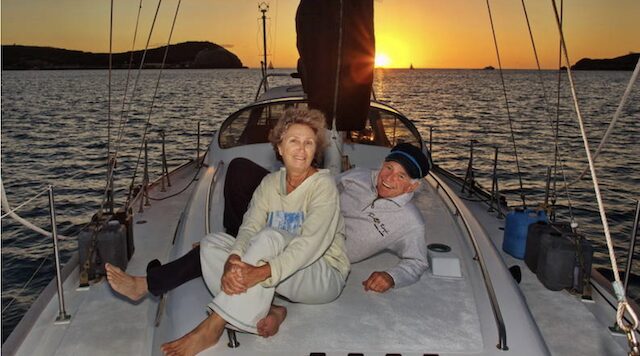

The 2025 Rocket Nautical and Travel Guides are the culmination of 25 years of continuous development. Except for the NASA space images and high-resolution aerial survey images, Frederique and Richard took almost every photograph in the Cruising and Travel Guides. They personally conducted complete hydrographic surveys of all anchorages, and the GPS routes featured in the guides are based on their own sailing tracks.
…………………………………
Related Links:
…………………………………
© 2025 Noonsite. This content was edited by Noonsite. Do not reproduce without permission. All rights reserved.
The opinions expressed in this article are the author’s own and do not reflect the view of Noonsite.com or World Cruising Club.
If you have found this information useful, become a paid member to enjoy unlimited use of Noonsite plus many other perks. Your membership fees really help our small, dedicated team keep country information up-to-date in support of cruisers worldwide. Find out more about Noonsite Membership levels and benefits here.
Subscribe to our FREE monthly newsletter: https://www.noonsite.com/newsletter/
Related to following destinations: Ambrym, Anatom Island (Aneityum), Anelcauhat, Asanvari Bay, Banks Islands, Chesterfield Islands, Divers Bay, Ureparapara Island, Efate, Epi Island, Espiritu Santo, Hienghene, Ile des Pins, Koumac, Lamen Bay, Lenakel, Lifou Island (We), Losalava, Gaua island, Luganville, Maewo Island, Malekula Island, Milli Bay, Mota Lava Island, New Caledonia, Noumea, Olal/Nopul, Port Resolution, Port Sandwich, Port Vila, Sola, South West Bay, Tanna, Touho, Vanuatu, Velit Bay Plantation (Shark Bay), Vureas Bay, Vanua Lava Island, Waterfall Bay, Vanua Lava Island
Related to the following Cruising Resources: Atlantic and Caribbean, Caribbean, Environment, General, General, Northern Europe, Pacific, Rallies, SE Asia




